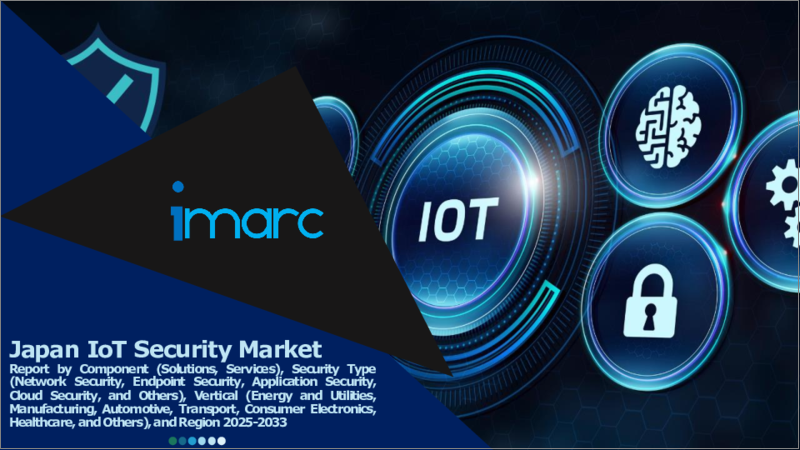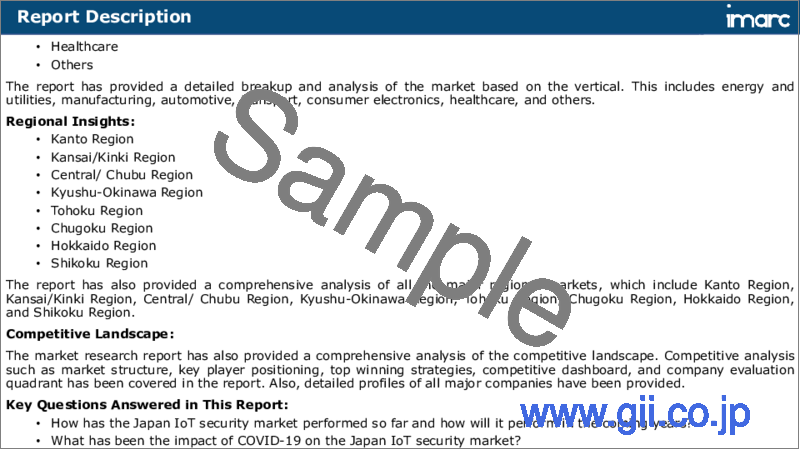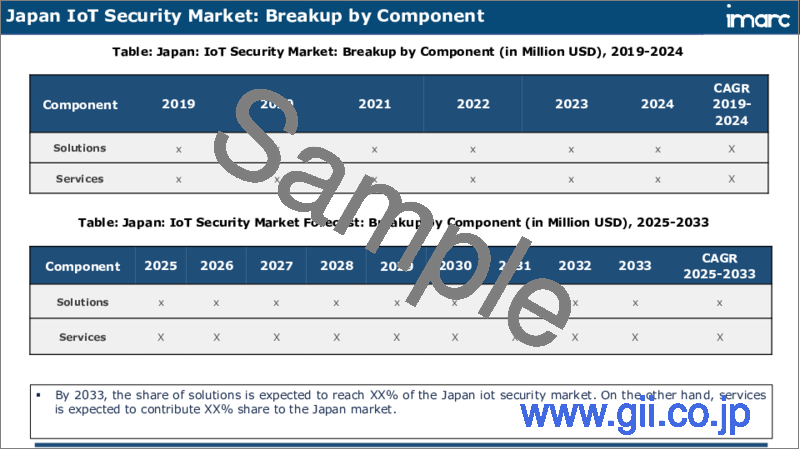|
|
市場調査レポート
商品コード
1729385
日本のIoTセキュリティ市場レポート:コンポーネント、セキュリティタイプ、業界、地域別、2025年~2033年Japan IoT Security Market Report by Component, Security Type, Vertical, and Region 2025-2033 |
||||||
カスタマイズ可能
|
|||||||
| 日本のIoTセキュリティ市場レポート:コンポーネント、セキュリティタイプ、業界、地域別、2025年~2033年 |
|
出版日: 2025年05月01日
発行: IMARC
ページ情報: 英文 122 Pages
納期: 5~7営業日
|
- 全表示
- 概要
- 目次
日本のIoTセキュリティの市場規模は2024年に3億2,130万米ドルに達しました。今後、IMARC Groupは、市場は2033年までに21億6,310万米ドルに達し、2025年から2033年にかけて21.6%の成長率(CAGR)を示すと予測しています。IoTデバイスに関連するセキュリティ侵害やインシデントが増加し、これらのシステムの脆弱性に対する意識が高まっていることが、主に市場を牽引しています。
本レポートで扱う主な質問
- 日本のIoTセキュリティ市場はこれまでどのように推移し、今後どのように推移するのか?
- COVID-19が日本のIoTセキュリティ市場に与えた影響は?
- 日本のIoTセキュリティ市場のコンポーネント別区分は?
- 日本のIoTセキュリティ市場のセキュリティタイプ別の区分は?
- 日本のIoTセキュリティ市場の業界別区分は?
- 日本のIoTセキュリティ市場のバリューチェーンにおける様々なステージとは?
- 日本のIoTセキュリティの主な促進要因と課題は何か?
- 日本のIoTセキュリティ市場の構造と主要プレーヤーは?
- 日本のIoTセキュリティ市場における競合の程度は?
目次
第1章 序文
第2章 調査範囲と調査手法
- 調査の目的
- ステークホルダー
- データソース
- 市場推定
- 調査手法
第3章 エグゼクティブサマリー
第4章 日本のIoTセキュリティ市場:イントロダクション
- 概要
- 市場力学
- 業界動向
- 競合情報
第5章 日本のIoTセキュリティ市場情勢
- 過去および現在の市場動向(2019~2024年)
- 市場予測(2025~2033年)
第6章 日本のIoTセキュリティ市場:コンポーネント別内訳
- ソリューション
- サービス
第7章 日本のIoTセキュリティ市場:セキュリティタイプ別内訳
- ネットワークセキュリティ
- エンドポイントセキュリティ
- アプリケーションセキュリティ
- クラウドセキュリティ
- その他
第8章 日本のIoTセキュリティ市場:業界別内訳
- エネルギーと公益事業
- 製造
- 自動車
- 輸送
- コンシューマーエレクトロニクス
- ヘルスケア
- その他
第9章 日本のIoTセキュリティ市場:競合情勢
- 概要
- 市場構造
- 市場企業のポジショニング
- 主要成功戦略
- 競合ダッシュボード
- 企業評価象限
第10章 主要企業のプロファイル
第11章 日本のIoTセキュリティ市場:業界分析
- 促進要因、抑制要因、機会
- ポーターのファイブフォース分析
- バリューチェーン分析
第12章 付録
Japan IoT security market size reached USD 321.3 Million in 2024. Looking forward, IMARC Group expects the market to reach USD 2,163.1 Million by 2033, exhibiting a growth rate (CAGR) of 21.6% during 2025-2033. The increasing prevalence of high-profile security breaches and incidents related to IoT devices that have raised awareness about the vulnerabilities in these systems, is primarily driving the market.
IoT (Internet of Things) security refers to the protective measures and strategies employed to safeguard Internet-enabled devices and the networks they're connected to. With the exponential growth of smart devices, from wearable tech to smart home systems, the potential for cyber threats and breaches has also surged. These devices, which often communicate without human intervention, can be gateways for hackers if left unprotected. Weak security can lead to unauthorized access, data theft, or malicious control of the devices. Consequently, IoT security emphasizes the need for rigorous cybersecurity practices, including secure coding, encrypted communications, and regular firmware updates. Furthermore, it encompasses the integration of physical security with cybersecurity, ensuring that devices are safe from tampering and eavesdropping. As the IoT ecosystem expands, proactive defense against potential vulnerabilities becomes crucial, necessitating collaboration between manufacturers, developers, and end-users. In sum, IoT security is not just about protecting individual devices but ensuring the safety and privacy of the interconnected digital and physical world.
Japan IoT Security Market Trends:
The IoT security market in Japan is experiencing robust growth due to several key drivers. Firstly, the proliferation of IoT devices across various industries has significantly expanded the attack surface for cyber threats. Consequently, organizations are increasingly recognizing the critical need for robust security solutions to safeguard their interconnected ecosystems. Furthermore, the rising frequency and sophistication of cyberattacks targeting IoT devices have raised concerns about data breaches, privacy infringements, and potential physical harm. This has propelled the demand for advanced security measures that can detect and mitigate these evolving threats effectively. In addition to these concerns, stringent regulatory mandates and compliance requirements have emerged as powerful catalysts for IoT security market growth. Governments and industry regulators in Japan are pushing for stricter security standards, forcing businesses to invest in comprehensive security solutions to avoid non-compliance penalties and reputational damage. Moreover, the convergence of IoT with other transformative technologies, such as artificial intelligence and edge computing, has created a complex and dynamic threat landscape. This complexity, which has led to a greater demand for sophisticated security solutions that can adapt to these evolving environments, is expected to drive the IoT security market in Japan.
Japan IoT Security Market Segmentation:
Component Insights:
- Solutions
- Services
Security Type Insights:
- Network Security
- Endpoint Security
- Application Security
- Cloud Security
- Others
Vertical Insights:
- Energy and Utilities
- Manufacturing
- Automotive
- Transport
- Consumer Electronics
- Healthcare
- Others
Competitive Landscape:
The market research report has also provided a comprehensive analysis of the competitive landscape. Competitive analysis such as market structure, key player positioning, top winning strategies, competitive dashboard, and company evaluation quadrant has been covered in the report. Also, detailed profiles of all major companies have been provided.
Key Questions Answered in This Report:
- How has the Japan IoT security market performed so far and how will it perform in the coming years?
- What has been the impact of COVID-19 on the Japan IoT security market?
- What is the breakup of the Japan IoT security market on the basis of component?
- What is the breakup of the Japan IoT security market on the basis of security type?
- What is the breakup of the Japan IoT security market on the basis of vertical?
- What are the various stages in the value chain of the Japan IoT security market?
- What are the key driving factors and challenges in the Japan IoT security?
- What is the structure of the Japan IoT security market and who are the key players?
- What is the degree of competition in the Japan IoT security market?
Table of Contents
1 Preface
2 Scope and Methodology
- 2.1 Objectives of the Study
- 2.2 Stakeholders
- 2.3 Data Sources
- 2.3.1 Primary Sources
- 2.3.2 Secondary Sources
- 2.4 Market Estimation
- 2.4.1 Bottom-Up Approach
- 2.4.2 Top-Down Approach
- 2.5 Forecasting Methodology
3 Executive Summary
4 Japan IoT Security Market - Introduction
- 4.1 Overview
- 4.2 Market Dynamics
- 4.3 Industry Trends
- 4.4 Competitive Intelligence
5 Japan IoT Security Market Landscape
- 5.1 Historical and Current Market Trends (2019-2024)
- 5.2 Market Forecast (2025-2033)
6 Japan IoT Security Market - Breakup by Component
- 6.1 Solutions
- 6.1.1 Overview
- 6.1.2 Historical and Current Market Trends (2019-2024)
- 6.1.3 Market Forecast (2025-2033)
- 6.2 Services
- 6.2.1 Overview
- 6.2.2 Historical and Current Market Trends (2019-2024)
- 6.2.3 Market Forecast (2025-2033)
7 Japan IoT Security Market - Breakup by Security Type
- 7.1 Network Security
- 7.1.1 Overview
- 7.1.2 Historical and Current Market Trends (2019-2024)
- 7.1.3 Market Forecast (2025-2033)
- 7.2 Endpoint Security
- 7.2.1 Overview
- 7.2.2 Historical and Current Market Trends (2019-2024)
- 7.2.3 Market Forecast (2025-2033)
- 7.3 Application Security
- 7.3.1 Overview
- 7.3.2 Historical and Current Market Trends (2019-2024)
- 7.3.3 Market Forecast (2025-2033)
- 7.4 Cloud Security
- 7.4.1 Overview
- 7.4.2 Historical and Current Market Trends (2019-2024)
- 7.4.3 Market Forecast (2025-2033)
- 7.5 Others
- 7.5.1 Historical and Current Market Trends (2019-2024)
- 7.5.2 Market Forecast (2025-2033)
8 Japan IoT Security Market - Breakup by Vertical
- 8.1 Energy and Utilities
- 8.1.1 Overview
- 8.1.2 Historical and Current Market Trends (2019-2024)
- 8.1.3 Market Forecast (2025-2033)
- 8.2 Manufacturing
- 8.2.1 Overview
- 8.2.2 Historical and Current Market Trends (2019-2024)
- 8.2.3 Market Forecast (2025-2033)
- 8.3 Automotive
- 8.3.1 Overview
- 8.3.2 Historical and Current Market Trends (2019-2024)
- 8.3.3 Market Forecast (2025-2033)
- 8.4 Transport
- 8.4.1 Overview
- 8.4.2 Historical and Current Market Trends (2019-2024)
- 8.4.3 Market Forecast (2025-2033)
- 8.5 Consumer Electronics
- 8.5.1 Overview
- 8.5.2 Historical and Current Market Trends (2019-2024)
- 8.5.3 Market Forecast (2025-2033)
- 8.6 Healthcare
- 8.6.1 Overview
- 8.6.2 Historical and Current Market Trends (2019-2024)
- 8.6.3 Market Forecast (2025-2033)
- 8.7 Others
- 8.7.1 Historical and Current Market Trends (2019-2024)
- 8.7.2 Market Forecast (2025-2033)
9 Japan IoT Security Market - Competitive Landscape
- 9.1 Overview
- 9.2 Market Structure
- 9.3 Market Player Positioning
- 9.4 Top Winning Strategies
- 9.5 Competitive Dashboard
- 9.6 Company Evaluation Quadrant
10 Profiles of Key Players
- 10.1 Company A
- 10.1.1 Business Overview
- 10.1.2 Services Offered
- 10.1.3 Business Strategies
- 10.1.4 SWOT Analysis
- 10.1.5 Major News and Events
- 10.2 Company B
- 10.2.1 Business Overview
- 10.2.2 Services Offered
- 10.2.3 Business Strategies
- 10.2.4 SWOT Analysis
- 10.2.5 Major News and Events
- 10.3 Company C
- 10.3.1 Business Overview
- 10.3.2 Services Offered
- 10.3.3 Business Strategies
- 10.3.4 SWOT Analysis
- 10.3.5 Major News and Events
- 10.4 Company D
- 10.4.1 Business Overview
- 10.4.2 Services Offered
- 10.4.3 Business Strategies
- 10.4.4 SWOT Analysis
- 10.4.5 Major News and Events
- 10.5 Company E
- 10.5.1 Business Overview
- 10.5.2 Services Offered
- 10.5.3 Business Strategies
- 10.5.4 SWOT Analysis
- 10.5.5 Major News and Events
11 Japan IoT Security Market - Industry Analysis
- 11.1 Drivers, Restraints and Opportunities
- 11.1.1 Overview
- 11.1.2 Drivers
- 11.1.3 Restraints
- 11.1.4 Opportunities
- 11.2 Porters Five Forces Analysis
- 11.2.1 Overview
- 11.2.2 Bargaining Power of Buyers
- 11.2.3 Bargaining Power of Suppliers
- 11.2.4 Degree of Competition
- 11.2.5 Threat of New Entrants
- 11.2.6 Threat of Substitutes
- 11.3 Value Chain Analysis






